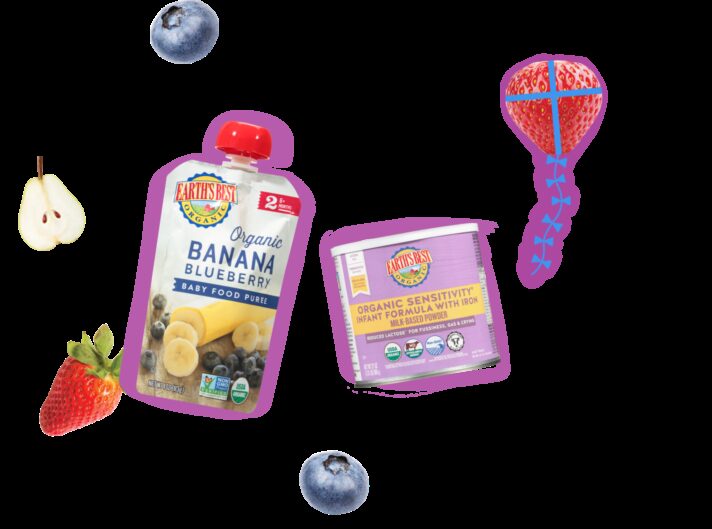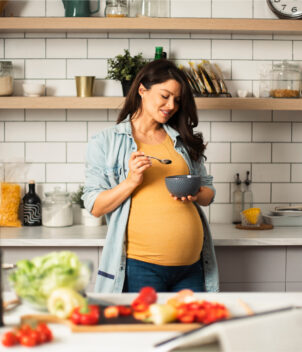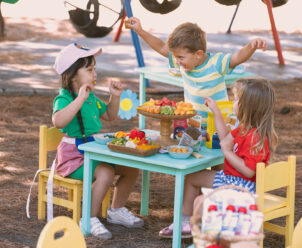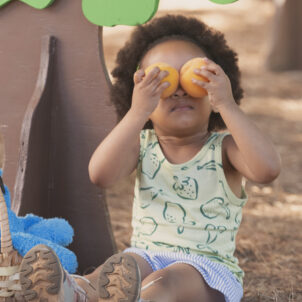

Kate Geagan, M.S., R.D.N.
Dietitian and sustainable nutrition pioneer
During the first year of your baby’s life every moment is special: from the first smile to the first step.
Use our baby development guide to learn about some of the amazing changes that occur along the way*.
1 month
- Moves head from side to side and raises head when lying on stomach
- Able to follow objects about 6 inches from face
- Responds to outside stimuli by crying, laughing, etc.
2 months
- The first signs of a genuine smile
- Recognizes familiar objects and people at a distance
- Brings hands to mouth
3 months
- Reaches out for toys or objects
- Follows objects in front of face from one side to the other
- Smiles at sound of parents’ voices
4 months
- Enjoys social play
- Opens mouth when food is presented
- Struggles to get objects out of reach
FOOD: When your child has reached these milestones you may consult with your child’s doctor about starting your baby on solids. Iron-fortified cereals, like Earth’s Best Organic® Oatmeal Infant Cereal are a good first choice.
5 months
- Able to hold head steady when standing or sitting up
- Recognizes people from a distance
- Smiles spontaneously
FOOD: If your baby has already been eating single grain cereals, now may be a good time to give you baby some variety such as Earth’s Best Organic® Multi-Grain Cereal.
6 months
- Hand and motor control developing rapidly
- Baby has learned to roll over in each direction
- At this age, about half of all babies babble, repeating one syllable such as “ga”, “ba”, “ma.”
FOOD: Continue feeding your baby iron-fortified cereals. Once your little one has enjoyed single ingredient purees you can then try simple combinations like Pears & Raspberries or Apple Peach Oatmeal.
7 months
- Sits without support
- Responds to own name
- Responds to “no”
FOOD: Continue your baby on iron fortified cereals while adding other strained varieties to try Sweet Potatoes & Chicken.
8 months
- Sits well without support
- Emotions become obvious, may mimic daddy’s or mommy’s behavior (ie: mommy laughs, baby laughs)
- Explores objects by shaking them, banging them, dropping them, etc.
FOOD: Some additional varieties to try this month include Vegetable Turkey Dinner.
9 months
- Crawls or creeps on hands
- Shows frustration (ie: toy being taken away)
- Stands by holding on to something or someone
FOOD: As your baby masters eating a variety of foods and is chewing, the progression to chunkier foods and more complex varieties begins. Food such as Chicken Pot Pie might be a good choice.
10 months
- Fingers have become agile and baby grabs at objects
- Baby’s personality emerges
- Begins to understand simple words and phrases
FOOD: Include some other Chunky Blends.
11 Months
- By now your baby is probably talking up a storm with words or word-like sounds spilling out
- Engages in parallel play (playing alongside another child but not with them)
- Becoming more independent, evident by their solo standing and squatting
FOOD: In addition to feeding your baby regular meals, try giving them finger foods such as small pieces of banana, well cooked pasta and peas. To avoid choking make sure anything you feed your baby is soft, easy to swallow, and cut into small pieces and never leave your baby unattended.
12 months
- Starts to stand for a few moments at a time and takes baby steps without support
- Says “Mama” and “Dada” to right person
- Claps hands and waves good-bye
FOOD: Babies and kids 12 months and older may enjoy soft fruit cut into small pieces (ie: blueberries, strawberries, etc.).
Last modified: February 11, 2020

We’re here to help! You and your little one are about to start an exciting adventure exploring lots of fun, new tastes + textures…and we're here to support you every step of the way!



